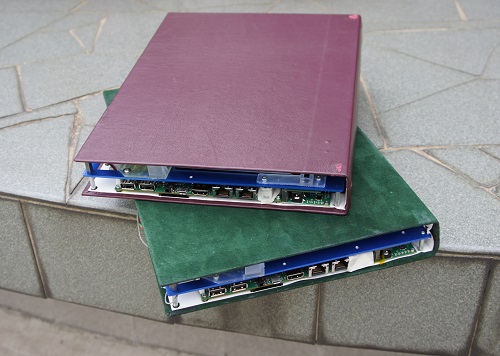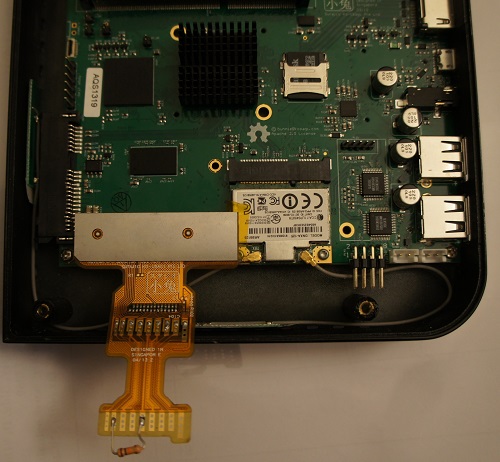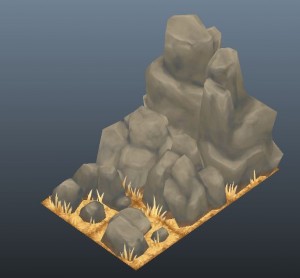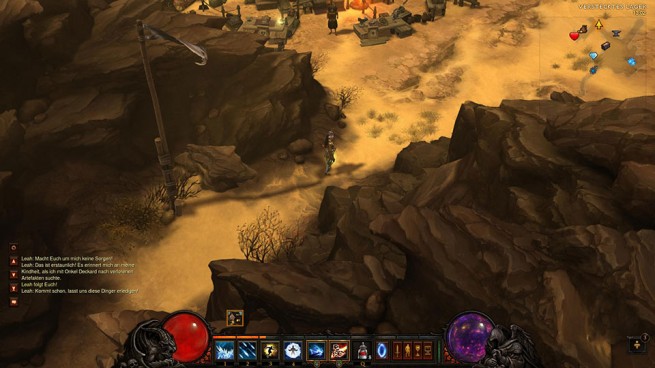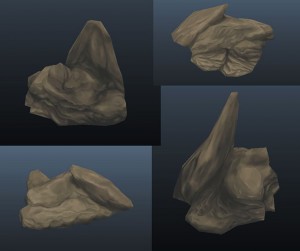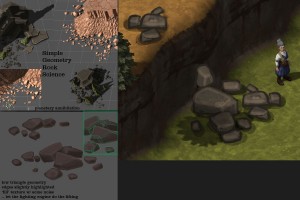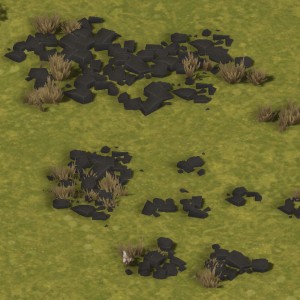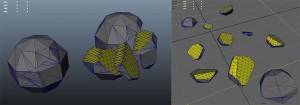Shared posts
Colorado River in Drought's Grip
Make: Article on Novena
Recently, the Make: blog ran an article on our laptop project, Novena. You can now follow @novenakosagi for updates on the project. I’d also like to reiterate here that the photos shown in the article are just an early prototype, and the final forms of the machine are going to be different — quite different — from what’s shown.
Below is a copy of the article text for your convenient reading. And, as a reminder, specs and source files can be downloaded at our wiki.
Building an Open Source Laptop
About a year and a half ago, I engaged on an admittedly quixotic project to build my own laptop. By I, I mean we, namely Sean “xobs” Cross and me, bunnie. Building your own laptop makes about as much sense as retrofitting a Honda Civic with a 1000hp motor, but the lack of practicality never stopped the latter activity, nor ours.
My primary goal in building a laptop was to build something I would use every day. I had previously spent several years at chumby building hardware platforms that I’m ashamed to admit I rarely used. My parents and siblings loved those little boxes, but they weren’t powerful enough for a geek like me. I try to allocate my discretionary funds towards things based on how often I use them. Hence, I have a nice bed, as I spend a third of my life in it. The other two thirds of my life is spent tapping at a laptop (I refuse to downgrade to a phone or tablet as my primary platform), and so when picking a thing to build that I can use every day, a laptop is a good candidate.
The project was also motivated by my desire to learn all things hardware. Before this project, I had never designed with Gigabit Ethernet (RGMII), SATA, PCI-express, DDR3, gas gauges, eDP, or even a power converter capable of handling 35 watts – my typical power envelope is under 10 watts, so I was always able to get away with converters that had integrated switches. Building my own laptop would be a great way for me to stretch my legs a bit without the cost and schedule constraints normally associated with commercial projects.
The final bit of motivation is my passion for Open hardware. I’m a big fan of opening up the blueprints for the hardware you run – if you can’t Hack it, you don’t Own it.
Back when I started the project, it was me and a few hard core Open ecosystem enthusiasts pushing this point, but Edward Snowden changed the world with revelations that the NSA has in fact taken advantage of the black-box nature of the closed hardware ecosystem to implement spying measures (“good news, we weren’t crazy paranoids after all”).
Our Novena Project is of course still vulnerable to techniques such as silicon poisoning, but at least it pushes openness and disclosure down a layer, which is tangible progress in the right direction.
While these heady principles are great for motivating the journey, actual execution needs a set of focused requirements. And so, the above principles boiled down to the following requirements for the design:
- All the components should have a reasonably complete set of NDA-free documentation. This single requirement alone culled many choices. For example, Freescale is the only SoC vendor in this performance class where you can simply go to their website, click a link, and download a mostly complete 6,000-page programming manual. It’s a ballsy move on their part and I commend them for the effort.
- Low cost is not an objective. I’m not looking to build a crippled platform based on some entry-level single-core SoC just so I can compete price-wise with the likes of Broadcom’s non-profit Raspberry Pi platform.
- On the other hand, I can’t spec in unicorn hair, although I come close to that by making the outer case from genuine leather (I love that my laptop smells of leather when it runs). All the chips are ideally available off the shelf from distributors like Digi-Key and have at least a five year production lifetime.
- Batteries are based off of cheap and commonly available packs used in RC hobby circles, enabling users to make the choice between battery pack size, runtime, and mass. This makes answering the question of “what’s the battery life” a bit hard to answer – it’s really up to you – although one planned scenario is the trans-Siberian railroad trek, which is a week-long trip with no power outlets.
- The display should also be user-configurable. The US supply chain is weak when it comes to raw high-end LCD panels, and also to address the aforementioned trans-Siberian scenario, we’d need the ability to drive a low-power display like a Pixel Qi, but not make it a permanent choice. So, I designed the main board to work with a cheap LCD adapter board for maximum flexibility.
- No binary blobs should be required to boot and operate the system for the scenarios I care about. This one is a bit tricky, as it heavily limits the wifi card selection, I don’t use the GPU, and I rely on software-only decoders for video. But overall, the bet paid off; the laptop is still very usable in a binary-blob free state. We prepared and gave a talk recently at 30C3 using only the laptops.
- The physical design should be accessible – no need to remove a dozen screws just to pull off the keyboard. This design requires removing just two screws.
- The design doesn’t have to be particularly thin or light; I’d be happy if it was on par with the 3cm-thick Thinkpads or Inspirons I would use back in the mid 2000′s.
- The machine must be useful as a hardware hacking platform. This drives the rather unique inclusion of an FPGA into the mainboard.
- The machine must be useful as a security hacking platform. This drives the other unusual inclusion of two Ethernet interfaces, a USB OTG port, and the addition of 256 MiB DDR3 RAM and a high-speed expansion connector off of the FPGA.
- The machine must be able to build its own firmware from source. This drives certain minimum performance specs and mandates the inclusion of a SATA interface for running off of an SSD.
After over a year and a half of hard work, I’m happy to say our machines are in a usable form. The motherboards are very reliable, the display is a 13” 2560×1700 (239ppi) LED-backlit panel, and the cases have an endoskeleton made of 5052 and 7075 aluminum alloys, an exterior wrapping of genuine leather, an interior laminate of paper (I also love books and papercraft), and cosmetic panels 3D printed on a Form 1. The design is no Thinkpad Carbon X1, but they’ve held together through a couple of rough international trips, and we use our machines almost every day.
 Laptop parked in front of the Form1 3D printer used to make its body panels.
Laptop parked in front of the Form1 3D printer used to make its body panels.
I was surprised to find the laptop was well-received by hackers, given its homebrew appearance, relatively meager specs and high price. The positive response has encouraged us to plan a crowd funding campaign around a substantially simplified (think “all in one PC” with a battery) case design. We think it may be reasonable to kick off the campaign shortly after Chinese New Year, maybe late February or March. Follow @novenakosagi for updates on our progress!
The first two prototypes are wrapped in red sheepskin leather, and green pig suede leather.
Detail view of the business half of the laptop.
On Hacking MicroSD Cards
Today at the Chaos Computer Congress (30C3), xobs and I disclosed a finding that some SD cards contain vulnerabilities that allow arbitrary code execution — on the memory card itself. On the dark side, code execution on the memory card enables a class of MITM (man-in-the-middle) attacks, where the card seems to be behaving one way, but in fact it does something else. On the light side, it also enables the possibility for hardware enthusiasts to gain access to a very cheap and ubiquitous source of microcontrollers.
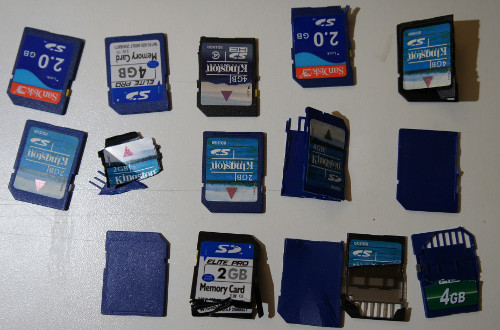
In order to explain the hack, it’s necessary to understand the structure of an SD card. The information here applies to the whole family of “managed flash” devices, including microSD, SD, MMC as well as the eMMC and iNAND devices typically soldered onto the mainboards of smartphones and used to store the OS and other private user data. We also note that similar classes of vulnerabilities exist in related devices, such as USB flash drives and SSDs.
Flash memory is really cheap. So cheap, in fact, that it’s too good to be true. In reality, all flash memory is riddled with defects — without exception. The illusion of a contiguous, reliable storage media is crafted through sophisticated error correction and bad block management functions. This is the result of a constant arms race between the engineers and mother nature; with every fabrication process shrink, memory becomes cheaper but more unreliable. Likewise, with every generation, the engineers come up with more sophisticated and complicated algorithms to compensate for mother nature’s propensity for entropy and randomness at the atomic scale.
These algorithms are too complicated and too device-specific to be run at the application or OS level, and so it turns out that every flash memory disk ships with a reasonably powerful microcontroller to run a custom set of disk abstraction algorithms. Even the diminutive microSD card contains not one, but at least two chips — a controller, and at least one flash chip (high density cards will stack multiple flash die). You can see some die shots of the inside of microSD cards at a microSD teardown I did a couple years ago.

In our experience, the quality of the flash chip(s) integrated into memory cards varies widely. It can be anything from high-grade factory-new silicon to material with over 80% bad sectors. Those concerned about e-waste may (or may not) be pleased to know that it’s also common for vendors to use recycled flash chips salvaged from discarded parts. Larger vendors will tend to offer more consistent quality, but even the largest players staunchly reserve the right to mix and match flash chips with different controllers, yet sell the assembly as the same part number — a nightmare if you’re dealing with implementation-specific bugs.
The embedded microcontroller is typically a heavily modified 8051 or ARM CPU. In modern implementations, the microcontroller will approach 100 MHz performance levels, and also have several hardware accelerators on-die. Amazingly, the cost of adding these controllers to the device is probably on the order of $0.15-$0.30, particularly for companies that can fab both the flash memory and the controllers within the same business unit. It’s probably cheaper to add these microcontrollers than to thoroughly test and characterize each flash memory chip, which explains why managed flash devices can be cheaper per bit than raw flash chips, despite the inclusion of a microcontroller.
The downside of all this complexity is that there can be bugs in the hardware abstraction layer, especially since every flash implementation has unique algorithmic requirements, leading to an explosion in the number of hardware abstraction layers that a microcontroller has to potentially handle. The inevitable firmware bugs are now a reality of the flash memory business, and as a result it’s not feasible, particularly for third party controllers, to indelibly burn a static body of code into on-chip ROM.
The crux is that a firmware loading and update mechanism is virtually mandatory, especially for third-party controllers. End users are rarely exposed to this process, since it all happens in the factory, but this doesn’t make the mechanism any less real. In my explorations of the electronics markets in China, I’ve seen shop keepers burning firmware on cards that “expand” the capacity of the card — in other words, they load a firmware that reports the capacity of a card is much larger than the actual available storage. The fact that this is possible at the point of sale means that most likely, the update mechanism is not secured.
In our talk at 30C3, we report our findings exploring a particular microcontroller brand, namely, Appotech and its AX211 and AX215 offerings. We discover a simple “knock” sequence transmitted over manufacturer-reserved commands (namely, CMD63 followed by ‘A’,'P’,'P’,'O’) that drop the controller into a firmware loading mode. At this point, the card will accept the next 512 bytes and run it as code.
From this beachhead, we were able to reverse engineer (via a combination of code analysis and fuzzing) most of the 8051′s function specific registers, enabling us to develop novel applications for the controller, without any access to the manufacturer’s proprietary documentation. Most of this work was done using our open source hardware platform, Novena, and a set of custom flex circuit adapter cards (which, tangentially, lead toward the development of flexible circuit stickers aka chibitronics).
Significantly, the SD command processing is done via a set of interrupt-driven call backs processed by the microcontroller. These callbacks are an ideal location to implement an MITM attack.
It’s as of yet unclear how many other manufacturers leave their firmware updating sequences unsecured. Appotech is a relatively minor player in the SD controller world; there’s a handful of companies that you’ve probably never heard of that produce SD controllers, including Alcor Micro, Skymedi, Phison, SMI, and of course Sandisk and Samsung. Each of them would have different mechanisms and methods for loading and updating their firmwares. However, it’s been previously noted that at least one Samsung eMMC implementation using an ARM instruction set had a bug which required a firmware updater to be pushed to Android devices, indicating yet another potentially promising venue for further discovery.
From the security perspective, our findings indicate that even though memory cards look inert, they run a body of code that can be modified to perform a class of MITM attacks that could be difficult to detect; there is no standard protocol or method to inspect and attest to the contents of the code running on the memory card’s microcontroller. Those in high-risk, high-sensitivity situations should assume that a “secure-erase” of a card is insufficient to guarantee the complete erasure of sensitive data. Therefore, it’s recommended to dispose of memory cards through total physical destruction (e.g., grind it up with a mortar and pestle).
From the DIY and hacker perspective, our findings indicate a potentially interesting source of cheap and powerful microcontrollers for use in simple projects. An Arduino, with its 8-bit 16 MHz microcontroller, will set you back around $20. A microSD card with several gigabytes of memory and a microcontroller with several times the performance could be purchased for a fraction of the price. While SD cards are admittedly I/O-limited, some clever hacking of the microcontroller in an SD card could make for a very economical and compact data logging solution for I2C or SPI-based sensors.
Slides from our talk at 30C3 can be downloaded here, or you can watch the talk on Youtube below.
Team Kosagi would like to extend a special thanks to .mudge for enabling this research through the Cyber Fast Track program.
No Rock Is An Island
(– Unless, of course, it is.)
Let’s talk about rocks. And let’s start with a screenshot from in-engine:
I hope we’re all familiar by now with how excited about the mundane I can get, see: loading bays, trees, etc. Rocks are totally mundane. But getting the mundane things just right is super important because it ties everything else together. High-poly fancy fantastic amazing show-off hero models & apocalyptic effects and animations are impressive, sure, but they need to exist within an artistic context that supports the claims they make and gives them meaning which resonates beyond their superficial visuals. Rocks tie the landscape together; The landscape is the stage on which the dramas of Clockwork Empires take place. Together they tie the whole game together.
So you see, rocks are important!
That said, we’ve had our, ahem, rocky starts and missteps which required iteration & experimentation to find our way. Here at Gaslamp we’re dedicated to using “Science!” — a more exciting and less accurate form of “science” — to solve our problems. In other words, we do aesthetic experimentation. If something could be better, we look at what other people have done, give it a think, see what we can use from the ideas they’re working with, then do an experiment and adjust it to the needs of Clockwork Empires. I’ve got a few experiments related to rocks to show you today and their results, together, gave us the shot you saw at the top of this post.
Experiment: Of Tiles & Minecraft
CE is fundamentally a tile-based game. Tile-based games go back a long way and, speaking for myself, I have many fond memories of A-Train, Caesar, Settlers, Anno, Sim City, and so on. Most of these games have rocks of some kind, so why not the traditional approach? Take some rocks, dump them in a tile (or weird hexagonal space), and now you have rocks.
This was also an early, confused period of CE’s development where we were experimenting with all kinds of crazy things like Minecraft-style voxel-looking terrain (we were young! it was cool!), or perhaps terrain that very strongly acknowledged that, yes, the entire world is built of tiles by having the tile borders draw distinctly into the grass & dirt of the terrain itself.
It was alright. But merely alright — if rocks are neat little piles set into their tiles, you get none of the majesty of mountains or the brute power of boulders. Just neat little stacks. CE is about a world bigger than that.
Experiment: Diablo 3 Rocks
Diablo 3 has amazing environmental art and there’s one weird trick to why they got away with it so easily. (I mean, aside from having a huge pile of cash and hundreds of artists and years to iterate on everything.) — And I’ll get to that in a sec. First, this:
I wrote up a ticket for Sean Hamilton, our environmental artist, to try to capture some aspects of these rocks. I wrote some of what I liked about them: “jaggedness”, “emphasis of edges which are jagged; sharp edges, though stylistically still quite painterly”, “sense of layering in geometry”. I think he caught that pretty well:
The difference between Clockwork Empires and Diablo 3, aside from everything else, is their one weird trick: a mostly-fixed camera angle. That and hand-crafted environmental pieces (which we may investigate aspects of, but that’d be a Daniel post) is why having beautifully painted, unique & individual rocks doesn’t look so awesome for us. We’d stick them down into the map randomly but each rock looked too much like itself, like a unique individual. Seeing it, you’d say “Hey, I know you — you’re that rock!”.
It was all very awkward. Especially for that rock. And ultimately it didn’t let us build a very cohesive landscape when taken altogether.
(For more on weird tricks, check out the talk that Diablo 3′s art director gave at GDC 2012 which was made public, he goes over a lot of what they did (which is fantastic), see here.)
Experiment 2: Planetary Annihilation Rocks
Alright, where can we find some pretty rocks — how hey, what’s that? Planetary Annihilation is a thing and it’s a thing with gorgeous concept art? Yeah, we follow the news. and look closely for developments relevant to the work we do, whether from the standpoint of gameplay, technology, or art.
So I made a ticket for Joseph Nejat, our character artist (who is making rocks, yes; truth is that we’re a small studio so there’s a blurred line between all the art positions): Can we capture what’s going on in those lovely little Planetary Annihilation rocks? Here’s what I wrote:
“What I think is going on is some fairly simple blocky shapes, stylized ideas of rocks, with a bit of edge highlighting to play that up a bit. Can pull terrain rock-face textures as a base — and these should be fairly flat — so that the geometry rendering & shadows they cast does the heavy lifting.”
This is almost the opposite approach from the Diablo rocks. Way less painterly, very low poly, using fairly flat textures so that the simple geometry of the rock itself interacting with the lighting expresses their form.
As you can see on the left, Joseph has an uncanny ability to reproduce assets from other games. They are a bit dark in-context though, colour could use some adjustment, and the scale is a bit limited, but those are PA rocks. So um, let’s not actually use those straight-up because Uber is going to totally sue us.
(Tangent on the subject of reacting to other people’s concept art: Patrick Wyatt has a fascinating series of blog posts about working on Starcraft — the first one — and how the game was entirely rebuild in part as a reaction to a competing tech demo the team saw at a trade show. But it turned out the tech demo was a pre-rendered movie with someone puppeting the act of playing the game. And guess what, that game was never released. But the takeaway is that Blizzard held themselves to someone elses’ impossible standard created by fake promotional art and it turned out great. Not that PA’s promo art was passed off as the actual game like those other guys, but the nature of concept art is that is is made in a very controlled environment so it always looks better than a real game. We’ve made some promotional renders here too and we do intend to exceed the standard they set. )
Still, we got some cool rocks. I overlaid the ryholite rock texture used by the base terrain itself, did a bit of colour adjustment, asked Joseph to do a few more size varieties, and we got some great scree material.
Scientific! aside: One idea Joseph dug up was taking a piece of geometry and running a shattering simulation in Maya and using those pieces as a basis for Planetary Annihilation style rocks, see to the right. Breaking stuff is cool, but the results are so high poly that the time it’d take to clean by hand would give better results if he just started from scratch.
Experiment: Lumpy & Blocky Rocks
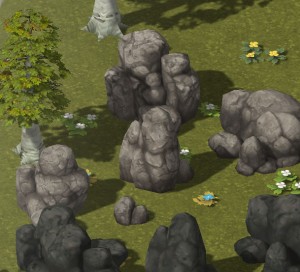
They’re like cold, unresponsive friends: Always there for you. Just cold and unresponsive. But you gotta work with what you’ve got, right?
Back to Sean: At some point I figured there was still something useful we can get out of a middle ground between Experiment 1 & 2, not so much as a reference to another particular game but as an iteration of the ideas Sean had been working with so far. I asked Sean to do up some “lumpy” and “blocky” rocks (with about that much description plus a sketch; and that’s how you art-direct). The results are to the right.
But we’ve still got a bit of the problem of the painterly rocks: they’re a bit too beautifully and individually rendered. Solution? Blurring & lowering contrast on the texture, and Sean doubled their size thus transforming the particular-object-looking details into something larger & more vague, more like aspects of the landscape. This lowered the resolution of detail to make them read more as background than subject.
Meanwhile, back At The Mine…
This brings us back to here, a hand-arranged set-piece assembled completely in-engine:
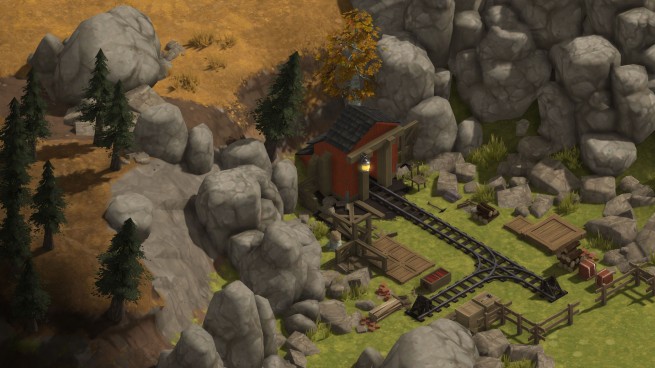
The happy little mine again! Hello happy little mine. How are you? Not collapsing? No underground springs waiting to flood us out? No pockets of explosive, poisonous gases? Splendid!
The rocks tie the hand-modeled objects to the procedurally-generated terrain, they bridge the gap of broad landscape features to the fine details of objects & characters. Then the shadows and ambient occlusion do their magic so you can jam it all right up together and it all looks like it was meant to be.
It’s starting to look like a game.
Always Multiply Your Estimates by π
Project estimation is a black art, nowhere more so than in game development. I once heard of a mysterious cabal of numerologists that multiplied their time estimates by π. The practice allegedly gave them sufficient buffer for new requirements, testing, iteration, and other arcane changes in scope.
This struck me as curious and arbitrary, but I was intrigued. I am now delighted to report that I have been able to put their Circular Estimation Conjecture on a firm mathematical footing.

Allow me to explain.
Someone — a designer, your lead, the exec producer, a friend, your mom — asks you to do something. You think for a bit, jot down a few notes, consider what’s required, and come up with a plan and an estimate.

But things change. Turns out there was some stuff your designer / producer / lead / friend / mom neglected to mention, and as you did the work you had some ideas to improve it further. Your scope grew.

And of course it didn’t all go smoothly. Your first try was an instructive failure. Then you rushed the second attempt and created a bunch of problems that took a while to fix. You spent two extra days to look at an alternative solution. All in all, you followed a positively circuitous path to your objective.

So how long did your journey take compared to your original plan? Turns out the numerologists were right …

And there you have it — whatever you think when you start, once you get through the research, design, discussions, prototypes, failures, testing, requirements churn, and all the other vagaries of the creative process, you will indubitably have done π times as much as you originally planned.
Now some may question my mathematical rigour, and even dispute what I believe to be the incontrovertible conclusion. People may claim that the correct multiplier is not in fact π — but that it is rather 2, or √2, or e, or the golden ratio φ. I am, however, aware of no one who claims the multiplier is less than one.
Regardless of your numerological leanings, the point is that you must give yourself permission to admit that — when you start a project — you don’t have the full picture, you don’t know how things will go, and there is work ahead about which you have almost no idea. No amount of planning and task analysis can change that, so don’t try too hard. Instead, give yourself a plausible buffer and get busy doing the work.
Oh, and that to-do list you made last weekend? It’s no coincidence you only got about a third of the things on the list done. ;-)
Approaching programming as a non-coder
 Ubisoft designer Yoann Pignole has been trying to get into programming -- and in his latest blog post, he shares how he's adapted the flowcharts he uses in his design work to better understand code. ...
Ubisoft designer Yoann Pignole has been trying to get into programming -- and in his latest blog post, he shares how he's adapted the flowcharts he uses in his design work to better understand code. ...
Blog: Game job boards for newbies
 New to the industry? This quick guide to using industry job boards should help clear up the basics of searching and applying for jobs, as well as offering tips on skill development. ...
New to the industry? This quick guide to using industry job boards should help clear up the basics of searching and applying for jobs, as well as offering tips on skill development. ...
What programming language should aspiring game developers learn in their free time?
I was asked this recently in private mail by someone heading off to University / College. For people choosing between a Computer Science/Software Engineering course vs. a Game Design / Game Development course, I’d said:
If you love games, you’ll do both anyway; one you’ll learn in lectures, the other you’ll self-teach. Which will you find easier to self-teach (given no-one is prodding you), and which will you need the extra benefit of having a formal course/teaching/teachers? (usually: people find it easier to self-teach “designing and making my own game experiments”. Usually, people find formal Computer Science / Maths is ‘hard’, and they need the help of a formal course)
Gross generalization: Most game-developers in the indie community are programmers; most of them are programmer-centric when looking at the world. I’m a programmer, but I’ve done approx 40% of my career in project-management and studio management (and even a tiny bit of publishing) over the years.
There’s one interesting point I want to clarify a little: By “indie community” I mean “focussing on the places filled with people who actually ship games”. Most game designers who want to make their own stuff have to learn programming, even if they’re 100% non-programmers, since it’s the only way to get “your” vision launched. Even the ones that started-off as pure artists often end up being highly technical (whether they admit that to themselves or not).
So … this is not a popular view, but I think it’s more accurate than most: by the time you finish a 3-4 year course starting “today” … C++ won’t be the game-dev language people care about. Already, for entry-level jobs most studios are more interested in “how good are you at Unity? How good’s your C#?”. That trend will only continue/increase.
More importantly, you eventually need to decide to focus on “making cool games that are uniquely fun” or “solving interesting programming problems using clever source code”.
If you prefer the former: you need to be a competent programmer – but the only thing that matters about the language is “how quickly can you convert your ideas into working, interactive, playable game?”. It could be javascript, C#, Java, Python – anything that’s popular and widely-used (because you’ll want there to be lots of existing code and libraries you can re-use, and lots of people to turn to for advice when you get stuck).
… ideally: you should have an idea in the shower this morning, write some sketches during this morning’s University lectures, and while eating lunch at your laptop have a prototype running by 2pm. Send to friends this afternoon, and by the time you go to bed, you’ve added 3 more features and pushed an update to your friends, who are already commenting on it by email.
If you prefer the latter: you need to understand programming more deeply, and what matters about the language is probably “how much control does it give you over how the code is executed?” (for which the ultimate option is “assembler”, but the second-best is “C++” and C++ is cross-platform where assembler is not)
… ideally: you should be thinking up complex tech that has the “WOW!” factor when you make a tech-demo to show it off. You spend a week thinking around a difficult problem – or something that’s not a problem, but is “too slow to do on today’s hardware” (for instance). A while later, you feel you have a good plan for tackling it, and spend a weekend making an experiment. The weekend after, you take the bits that worked, refactor them, re-write the bits that didn’t, use some more programming tricks, optimize bits, try a new algorithm. A week after that, you write a tech-demo that shows visually/aurally/performance/networking (client and server interacting) the “thing that was impossible or too slow for people to try doing before”. You push it out to HackerNews and get a lot of coders tearing it to pieces (in a positive way) trying to understand what you did and how, and trying to reproduce it.
2D shooter pixel art, from concept to execution
 From enemy graphics to background animations -- to logo and box design -- this post covers getting retro feel right in the modern era. ...
From enemy graphics to background animations -- to logo and box design -- this post covers getting retro feel right in the modern era. ...
Blog: Redesigning Battleship to make it fun again
 Can you take a limited game design and add new elements to make it more fun? Rob Lockhart redesigns classic board game Battleship to put that theory to the test. ...
Can you take a limited game design and add new elements to make it more fun? Rob Lockhart redesigns classic board game Battleship to put that theory to the test. ...
Root Cause - Gen Con 2013
Last month was great for all of us. We got the spoils from the first data pack of the Spin Cyle - Opening Moves -, some bad#$$ ships for X-Wing, and the Justin Kopinsky's victory with the same identity cards used by David Kempe last year. That weekend was a very hyped one.
The Spin Cycle is a huge step for the anarch players. Remember all the times you tried to build a Whizzard: Master Gamer deck, and it had so many virus program cards that you ended up using Noise: Hacker Extraordinaire? Now, your problems have not only one solution, but two.
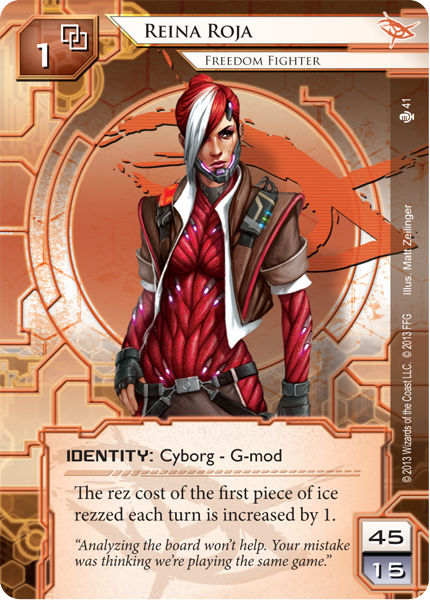
The second one is not actually a solution, but kick in Noise: Hacker Extraordinaire's butt. Jackson Howard counters this runner's ability so badly that we might not see as many Noise/Shop decks as we used to see. And look at its trash cost, it is the perfect victim for Whizzard: Master Gamer's ability. Of course that most players will trigger it before it is trashed, but the simple threat of instantly trashing Jackson Howard makes Whizzard: Master Gamer looks good. I wouldn't feel safe knowing that the Corp can draw 2 cards per click, at least.
Things like the dangers of illicit pieces of ice and how good bad publicity will be for runners is hard to judge right now, because those things are too young. Let's focus on the cards we already have: what can we learn from the GenCon 2013 tournament?
Desperado (Core) + Datasucker (Core) - 6 out of 5
Ok, this is something that we already knew before GenCon 2013, but I don't think I ever talked about it. Desperado and Datasucker have a great synergy with each other - they are so good together that the tournament champion spent 80% of his influence limit just to have this combo on his deck. I'll say it again because that has to be clear for you: it is THAT FREAKING GOOD!
The problem is that each Desperado costs 3 influence points, and you must draw it as soon as possible in order to make the most of it, so you need the 3 copies in your deck. What can we use with the others 6 influence points? We can use Aesop's Pawnshop and keep the traditional archetype, or we can go for the credit denial deck, using Forged Activation Orders, Emergency Shutdown, or even a single copy of Account Siphon. My personal option? Credit denial with 3x Desperado + 3x Forged Activation Orders.
Versatility > Efficiency
If you look at the decks of both finalists, you'll find a pattern. There are 8 icebreaker cards in their decks - 7 of them are AI program cards, and 1 of them is a Femme Fatale. While AI program cards are expensive to use for running, the fact that they break anything puts a lot of pressure on the Corp. We not only can add Atman (Creation and Control) to our decks and replicate the rig used by the GenCon 2013 champion, we also have two AI program cards that can be searched with Djinn.
I tested a lot of different rigs for my Anarch deck, and I believe the one I'm using currently is the best one. Why? Because of the AI program cards. The icebreaker selection used by David Mauro to win the Philadelphia regionals in june is really godlike:
1x Corroder
1x Mimic
1x Femme Fatale
1x Crypsis
1x Darwin
Conventional icebreaker program cards (like Mimic) paired with an AI gives you both versatily and efficiency. What else could you want? If you're not a fan of Darwin or Crypsis, you can also try some copies of Atman and/or Wyrm.
The new age of Economy
Forget about Magnum Opus and Liberated Account and welcome Dirty Laundry (Creation and Control) and Daily Casts (Creation and Control). The economy cards brought by Creation and Control are both godlike for us, because most Anarch decks rely on Wyldside to draw cards, and they need as much "click-efficiency" as they can have. Daily Casts is even better, because it has synergy with Aesop's Pawnshop, allowing you to get 5 credits at the same turn without spending a click.
You can also see that both Justin Kopinsky and Jimmy Risk were running Kati Jones (Humanity's Shadow) rather than Armitage Codebusting. If you're familiar with my posts you probably know how much I like Armitage Codebusting, and I can't say that I think it is dead yet. It is cheaper and faster than Kati Jones, and it is not something that should be forgotten. As a general rule, if you want to be more aggressive on early game, go Armitage Codebusting; if you need to take your time building a rig, go Kati Jones. Most decks won't need to run both these cards.
Noise/shop = BFF
The Personal Workshop vs Sahasrara debate is not over, and honestly, I don't think it will ever be. They are both great for virus programs based decks, and as the cardpool grows, we'll get more Anarch cards (making influence less important) and more out of faction cards (making influence more important). With so little time to test things (we get more cards every month), intuition will be the the main factor - and, in some cases, the only factor - that we can use to decide about which one we're going to use.
I played a lot with both of these cards, and I really can't tell you which one is the best. Personal Workshop synergizes greatly with Stimhack, making your attacks a lot more unpredictable, but Sahasrara low influence cost allows you to use some nice things like The Maker's Eye or Inside Job. No matter which one you're using, it is the right decision. And the wrong one too.
Getting ready for more.
Now, it is time to get ready for the World Championship, in November. Last year, it was particularly cool, because we had the same card pool that we had had in GenCon 2012, and we could actually see how much the meta evolved from the day 1 to the stable meta from the Core Set days. This year, the card pool will keep growing, and some archetypes that worked in GenCon won't work in the World Championship.
I don't think that Mala Tempora will be available before November 7th, so I wouldn't count on Reina Roja if I were you. Maybe you can start to think about your "Exile/Caissa" deck (some people believe that using one Pawn to bring another Pawn to the board is a efficient way to keep Exile ability triggering over and over), or maybe you can start to try to find a good way to include Hard at Work in your deck. If you want to try something that people say it won't work, now it is the time to do it.
About the things we already have, I don't think it is going to change too much. Fast advance Corp decks will be as strong as they are now, Atman/Datasucker decks will be as strong as they are now, etc. Some players are betting that Jackson Howard (Opening Moves) is going to make Noise/Shop (or Noise/Sahasrara) unplayable, but I wouldn't care that much. Virus programs are good with or without Noise: Hacker Extraordinaire, so if you like this archetype, don't give up yet.
And as we're talking about decks, I think it is time for me to share mine again (I believe the last time I posted a deck of mine was before Cyber Exodus). I see that a lot of people having trouble building an efficient Anarch deck, and maybe my list can give you some ideas, or maybe you have some tips for me (Wyld/Shop v3.1). Feel free to share your own decks or to ask whatever doubt you have.
Don't forget to check Jimmy Risk (link here) and Justin Kopinsky (link here) deck lists! See'ya!
João “Hraklea” Almeida is a brazilian amateur card game player with almost 15 years of experience. Currently playing Android: Netrunner, Dragon's Crown, and maybe coming back to Marvel vs Capcom 3 and King of Fighter XIII.
A single game as a lifelong hobby
Do you finish one game and then move onto the next? This is the dominant pattern of play for gamers. What happens when players stop consuming and starts investing in a single evergreen computer game for years on end?
Players of traditional games specialize
Across the 5500+ year history of gaming and sports, players typically focus on a single game and turn it into their predominant hobby. A chess player may dabble in other games, but chess is their touchstone. They join chess clubs, they play with fellow chess fans and they spend 90% of their gaming time playing chess. Overall, players specialize.Such players do play other games, but to a far lesser degree.
There are also communities that embrace the identity of being good at multiple games or sports. These are a minority.
And some are inclined to claim all hobbyists are 'athletes' or 'players' and thus unified in some common tribe. Such verbal gymnastics rarely provide much insight into a dedicated hobbyist's specific passions or the nature of their community.
Specializing in a hobby occurs for many reasons. Traditional sports or games often have the following attributes:
- Evergreen activities: You don't beat them. You stop when you get bored. Usually they consist of nested loops that operate on time scales of up to a generation. Consider the nesting of Match : Event : Season : Career : Training the next generation.
- High mastery ceiling: Most are nearly impossible to master completely. You can always get a little better. You can always get better at Go, Soccer or Poker.
- Strong communities: There exist strong social groups of like-minded players that have their own group norms, hierarchies and support structures. To be a dedicated basketball player is to be part of an extensive basketball playing network.
- Life long identities: Someone who excels in the game starts to identify as a member of that group. The game becomes source of purpose bigger than themselves. They can look back on their life and say "There were some ups and downs, but I'm secure in my accomplishments as a player of game X"
-
Grass roots or service-based business models: Any cultural structure can be fruitfully analyzed by understanding the flow of money. Many traditional games have extremely low barriers to entry. It costs little to access the initial equipment. Often items like decks of cards or chessboards are either communally owned or purchased by a family and one set of equipment serves multiple participants.
At higher levels of play, cash flows into the ecosystem through purchases of more advanced or higher status equipment or various service, membership or event fees. In all cases, the businesses involved have strong financial and culture incentives to get you playing and keep you playing.
Players of digital games consume
The hobby of computer or console gaming follows a different usage pattern; gamers play a wide variety of games. NPD claims core gamers buy an average of 5.4 games in a 3-month period. In a recent discussion of Steam purchases on Kotaku, commentators chimed in that they had purchased 100 to 800 games. These are played for a period of time and then set aside so that a new game might get some play.These players specialize far less. They may prefer a genre of games such as RPGs or shooters, but they'll still consume many games within that genre.
Why the difference in playing patterns? Commercial digital games have some distinct attributes that encourage serial play instead of evergreen play. Not all digital games fit this mold, but the trends are worth noting.
- Complete-able games: Most computer and console games can be completed in 5 to 40 hours. It is rare that you find digital games that retain users longer than 6 months. Actual playtime is shorter than the official length since most players do not complete their games and even fewer play through a title more than once. Compare this to the generational nested loops of traditional evergreen games.
- Narrative and Puzzle-focused gameplay: The majority of the gameplay is focused on high burnout single use puzzles or evocative narrative stimuli. Designers spend their budget handcrafting specific scenarios for maximum emotional impact the first time through.
- Low mastery ceilings: Since the design goal is to move players through the content of a game as smoothly as possible, the game mechanics are generally balanced towards the average skills of first time players. It is rare and surprising when a single player narrative computer game offers examples of masterful play. All this leads to early burnout where players rapidly become 'bored' and put the title aside.
- Weak player identities: It is difficult for a player to establish their identity around their excellence in any one game. To be a good Braid player just isn't that special. Lots of other people have walked the same path; there is little player creativity and outside the occasional Let's Play video, few people care.
- Content-focused business model: Digital games businesses have a strong financial incentive to get you to pay upfront and then move onto their next title. Games are treated as a content or boxed product business. An optimal strategy is to put high quality boxes on shelf (either physical or virtual) and get people to buy as many boxes as possible. Since exciting content remains a large cost center, there is ever increasing pressure to make games flashier and more marketable on the front-end and shorter on the back-end.
This fits the general profile of a media hobbyist. As we shifted from evergreen hobbies to digital retail-focused games, we trained users to behave in a fashion similar to that of a reader who reads many books or a movie goer who watches many movies.
A media culture
To be a 'Gamer' is to buy into numerous requirements that only exist to enable the creation of easily consumable media products.- Reviewers exist to help players select their next media purchase
- Critics exist to demonstrate how media conveys a message to society. They are trained (if they are trained) in other media-centric fields such as movies or literature. There is little systemic thinking since media is first and foremost not a functional system but an evocative stimuli.
- The form of popular games is determined by whether or not it fits in a media box. Form is the standardized structure of a piece of media. The 2-hour narrative movie is a form of video. The 300 page novel is a form of writing. So too is the 14-hour adventure game or the level-based narrative FPS.
- Stores and storefronts exist to sell the hobbyist a steady trickle of new media. Since media creation is expensive and the share of a player's time is small for any single piece of media, aggregators of content are typically 3rd parties that don't produce all the media themselves.
- Communities are built around mass media that act as a shared experience for large populations of consumers. Big brands like Mario, Mass Effect or Final Fantasy form cultural anchors much like Star Trek or Star Wars. Comparisons, reminiscences and fan fantasies about future sequels or expansions are common.
Digital evergreen hobbies
Into this media-centric ecosystem we've seen the reemergence of major games that hew more closely to the traditional games of old. MMOs like World of Warcraft or MOBAs like League of Legends are services. A digital game like Minecraft ties into numerous communities and is often played for years. Some like Halo or Call of Duty cleverly camouflage themselves as traditional consumable boxed products all while deriving long term engagement and retention from their extensive multiplayer services. These games share many of the attributes of older hobbies:- They attempt to be evergreen.
- They have high mastery ceilings and robust communities.
- Many, especially eSports, replicate the nested yearly loops of a traditional sport.
The rise of services
This shift to services is accelerating, driven by business factors and steady player acceptance. Developers are slowly coming around to the realization that an evergreen service yields more money, greater stability and a more engaged player base. Experiments of the past few years with social, mobile and Steam games suggest that microtransactions will likely become a majority of the gaming market. They already represent 70% of mobile revenue and continue to grow rapidly on other platforms.This new revenue stream places new constraints on game designs. Types of laboriously handcrafted content that was once feasible when your game was played 10 hours is no longer profitable if revenue trickles in over hundreds or thousands of hours of play. Deep mechanics once again matter. Communities you want to spend time in become a competitive advantage.
There are indeed manipulative companies scamming settlers in this newish frontier. Don't act so surprised. This is the case for any frontier and this is not the first time games have attracted disreputable developers. Look beyond the flashy, inevitable crooks, just as you looked beyond the licensed games, the porn games and the gambling games that infest your typical game markets. Look at the big picture and observe where the new opportunities for greatness blossom.
No, they won't cross over
These new evergreen players become hobbyists, but not media-centric gamers. This is most evident in the audiences that play 'casual' social and mobile titles. Many of these players never bought into the current gamer culture. It is common to see someone deep into Candy Crush and when you ask them if they are a gamer, they will deny it. They do not 'game', they never have 'gamed'. They don't share a common heritage of Mario, Zelda, COD, Halo or any of the mass media touchstones that unite current gamers. What they have is a wonderful hobby that in their mind has nothing to do with existing computer games.There exists a fantasy that somehow new players will get hooked on one game and then transfer over to consuming other games. Since this assumes a play pattern of high volume serial consumption, I doubt that this will occur. Great evergreen games leave little room in a hobbyist's schedule for grand feasts of consumable content. You don't finish a great hobby and then look for your next dalliance. You keep playing the game for years or even generations.
The perfect service-based game is one worthy of your entire lifetime of leisure.
If this seems an exaggeration and current titles feel unworthy of this high bar, wait a while. Developers are very talented. And the financial incentives to build the perfect service-based game are strong.
Not one gaming hobby but many
So where does that leave our understanding of 'gaming?'- Some people avidly knit in their leisure hours.
- Others play a creative game like Farmville, Dwarf Fortress, Minecraft or the Sims.
- Others participate in a social online game like World of Warcraft, Eve or Facebook.
- And then there is a small but active community of proudly old-school Gamers that like consuming puzzles and story media.
There are those who might see this as a threat, but that is mere fear talking. Existing hobbies tend to last for at least a generation. Those who've tied their identity to consuming media-style games as their hobby will stop participating in the hobby when they die. I expect to see 80-year olds still buying adventure games because that is what they were raised on and that is what they love. Niche producers can make good money serving these avid fans. The rise of new hobbies thus do not invalidate a current hobby. In fact, you'll have media-centric games for at least the rest of your life.
Though each hobby likely will need to compete for new members.
Impact on the cultural ecosystem
With this shift comes change. The following may challenge your existing expectations.- Specialized interests, not shared experiences: The drop rates on defense potions matters little to your typical gamer. Yet it is of earth shattering importance to the community of Realm of the Mad God players, impacting hundreds of hours of their life. At a certain level of mastery, the language used to describe in-game concepts becomes indecipherable to casual audiences. This inhibits communication with external groups, but facilitates bonding within the group.
- Deep systemic analysis, not broad media criticism and reviews. Hobbies are predominantly comprised of human systems and communities, not texts to analyze or boxes to sell. Political, anthropological or economic forms of discourse are more appropriate yet there are few game critics trained in these fields. Successful commentators are typically past players with a master-level understanding of the hobby. They are rarely dilettantes flitting from media event to media event.
- Unique cultures, not mass cultures: A hobby can develop a set of inward facing social norms. This can be a negative if extreme viewpoints are allowed to fester. It can also be a huge positive and promote inclusivity, equality and long term positive relationships. Each hobby is a cultural petri dish that need not adopt dominant tropes or values.
- Participation, not marketing campaigns: New players of a hobby hear about it from a friend or stumble upon a free trial. They participate first and see if they enjoy the lifestyle that the hobby promotes. Big bang media events can flood the early stages of the acquisition funnel, but they do not directly result in revenue or a sustainable community.
Let a thousand flowers blossom
The concept of one true gamer community will be less feasible as evergreen hobbies grow in popularity. Instead, we have a crazy mixing bowl of diverse, separate, long-term communities. Few will share the same values or goals. Few players will consider themselves having anything in common with players of a different game.Social organizations such as PAX will still promote common ground, much like the Olympics promotes common ground between athletes. But day-to-day cross-pollination will be rare.
I personally value a wild explosion of diversity. We need less mass culture and more emphasis on vibrant, generative communities instead of passive industrialized consumption.
The existing society of players may be tempted to deal with those not like themselves negatively through shaming ("I can't believe you play Farmville, stupid person!") Here's how we might instead react positively.
- Freedom of Play: Like freedom of religion, any player has a right to devote their life to any game even if it isn't something enjoyed by another player.
- Mutual respect: Any player deserves your respect for their hobby even if you do not personally understand it. Avoid stereotypes and engage with the person.
- Willingness to explain: Any insider should be willing to explain to an outsider how their hobby works. Proselytize by inviting them to play with you. An open-minded outsider should be willing to listen.
take care,
Danc.
References and Additional Links
- Tie ratios 2012: http://www.gamasutra.com/view/news/184899/
- Do you play other MMOs: http://wow.joystiq.com/2013/04/04/breakfast-topic-do-you-play-other-mmos-besides-wow/
- Games per month: http://www.eurogamer.net/articles/2011-06-27-core-gamers-game-18-hours-a-week-npd
- Games are not media: http://gamedesignadvance.com/?p=1567
- Aging model train enthusiasts: http://www.009.cd2.com/young.htm
- What the dying of a hobby actually looks like: http://www.nytimes.com/2003/01/15/nyregion/graying-playing-with-trains-2-midtown-hobby-shops-struggle-customers-dwindle.html
- Shaming of a misunderstood hobby: http://www.butterfliesandwheels.org/2011/on-the-vilification-of-rail-enthusiasts-and-what-this-tells-us-about-contemporary-society/
- Data says big spenders act like hobbyists: http://www.gamesindustry.biz/articles/2014-04-01-free-to-play-whales-more-rational-than-assumed
Developers cloning game ideas? Blame it on communication
 Longtime Epic Games dev-turned-indie Lee Perry argues that one reason we see so many ideas repeated from game to game is that communicating truly original ideas to a team is just too tough. ...
Longtime Epic Games dev-turned-indie Lee Perry argues that one reason we see so many ideas repeated from game to game is that communicating truly original ideas to a team is just too tough. ...
fosfodiesterlamina: enamorado-de-ti-ma-cherie: mehueleelpitoaca...




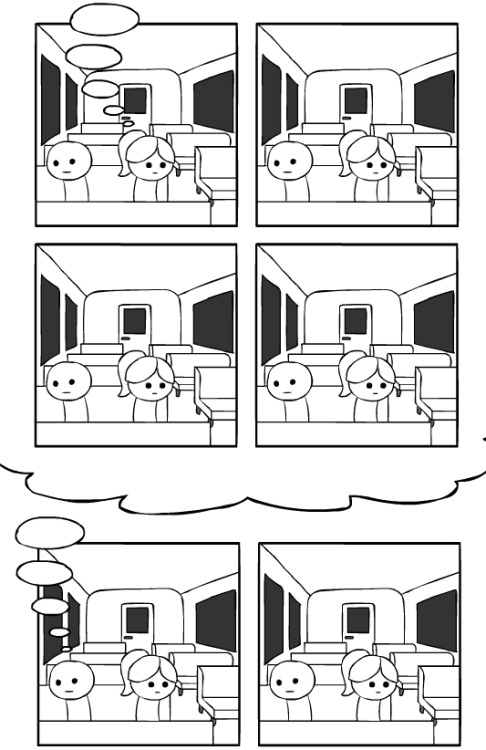




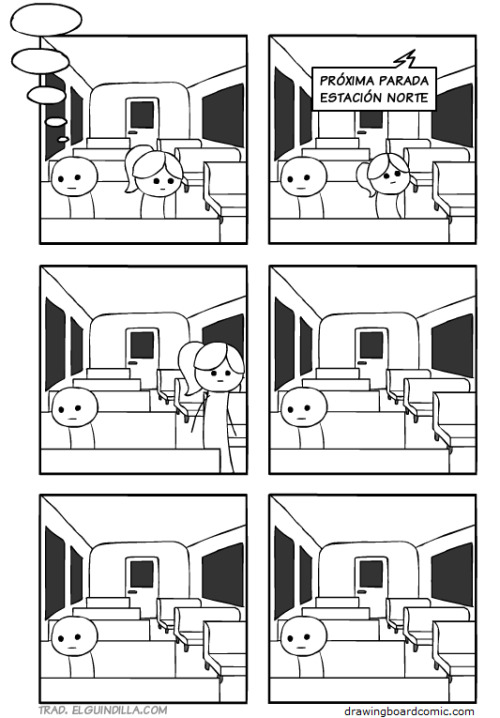
Esto si qué es pensárselo demasiado.
uno de los mejores post que eh visto es uno de mis favoritos :l
vale la pena leerlo
aveces si lo piensas mucho…………….es mejor actuar en el momento♥
The monetization secrets of Candy Crush Saga and Puzzle and Dragons
MakaiVery good article on how F2P mobile games try to trick users to monetize off of them.
 They're two of the most profitable games in the world right now. How do their monetization engines tick? Virtual economist Ramin Shokrizade opens them up. ...
They're two of the most profitable games in the world right now. How do their monetization engines tick? Virtual economist Ramin Shokrizade opens them up. ...
Dispelling some myths for the indie studio newbie
 Think you have a great idea? That will only get you so far, as this post from a "moderately successful" indie developer (enough to self-fund development) attests. There's much more to it. ...
Think you have a great idea? That will only get you so far, as this post from a "moderately successful" indie developer (enough to self-fund development) attests. There's much more to it. ...
PAR The Cut: Maturity, skill, and craft: why games as art conversations usually miss the point
Teaching; Programming apprentices
We have a huge problem.
The knowledge gapI’ve been a professional programmer now for over a decade, and during this time I’ve met a LOT of excellent programmers. Most of them are partially autodidactic and learned the business side of programming in school. But non of these guru’s/experts use their skills to teach the [...]
How can I make my games more inclusive?

[by Daniel Cook]
The good people in my life come from all sorts of walks of life. Some women, some boys, some rich, some poor, some gay, some transgender, some young, some old, some confused, some depressed, some wildly liberal and some staunchly conservative. Some embrace labels. Some can't abide labels. They sport different cultures, colors, nose shapes, hair types, sizes and everyone single one of them has a bizarre personal history full of dreams, joys and misery.
I'd like all of them to play my games.
I'm a rather reserved fellow and my games are one of the few ways that I connect with the rest of humanity. In my ideal world, people would approach my games with an open mind and if something sticks, great. What I find can happen instead is that I blindly duplicate standard video game fallbacks and in the process accidentally and needlessly alienate people I really respect.
Some inclusive design goals
The following is a list of design goals I try to keep in mind. Not all my games succeed at every one of these and some are goals for future games that I haven't managed to release. But the attempt is made. Then I will listen to feedback and try again.
1. Less visceral violence
Visceral, bloody violence where the game revels in harming realistic people is only fun for a very specific audience. It turns out that you make an impact on people without the use of shock. Turning everything up to 11 in terms of gratuitous gore becomes a choice rather than the default that all games must attain.
Cartoon violence has its place, especially in the clear communication of physical cause and effect. Yet even this class of violence can be avoided if you start exploring system that don't involve hitting or shooting things.
2. Fewer pinups
Let's hear it for the wonders of great sex between willing adults. However, many cookie-cutter sexy characters are more about non-consensual power, dominance and ogling than they are about sex, sexiness or love.
Do you really need bikini babes or beefy man nipples to make the sort of games you want to make? Could you improve your game by adding interesting relationships or clothing?
3. More cooperative social dynamics
Instead of strict player vs player, I try to make games that encourage cooperative play. Is the game set up where helping one another is possible or encouraged? Many games drift thematically and mechanically towards harming others.
While, it is certainly possible to have competitive play that encourages sportsmanship, there are some great opportunities in games outside pure individualistic competition. Change the dynamic from "If you play, I will destroy you" to "Hey, let's play together"
4. Less Pink and Blue art
There are historical (post 1940's) art styles that are marketed as distinctly 'pink' for feminine audiences or 'blue' for masculine audiences. Think Barbie and G.I. Joe.
I prefer what I think of as 'green' art that is its own thing and doesn't actively push one audience away. This isn't compromised 'purple' art, which in the end is still just a muddled committee's reaction to stereotypes. Instead, push all that aside and aim for a raw expression that appeals to people with an appreciation of honest beauty and delight.
5. Fewer wholesale stereotypes
Stereotypes, as a form of pre-baked mental schema, can act as an entrance into a game. With a single word or phrase, you trigger an entire model of how the world works. But these cheap schema have two critical issues:
One, they can also blind people to the unique quirks of another person or another perspective. Two, the wholesale usage of a stereotype brings along a wide variety of uncomfortable baggage that while invisible to one group ends up being blatantly off-putting to another.
An alternative to using stereotypes is to thoughtfully construct your themes piecemeal from a large variety of influences. When you look at the art for Road Not Taken, it can be difficult to put the world into a broad existing stereotype. By constructing your own theme, you can at least ensure any insults or blindspots are something you own.
6. More avatar variety
Where appropriate, enable selection of character of a variety of genders, skin tones and personalities. Allow mixing and matching so players feel a sense of ownership over their identity within the game. Not exactly rocket science. Even narrative games could stand more player ownership of the character without overly sacrificing their god-given right to author choose-your-own adventures.
7. Welcoming divergent sub-cultures
Does the game support the growth of divergent sub-cultures? I can't represent everyone but I can provide nurturing play spaces for people whose experiences, personalities and goals are unlike mine.
One of my favorite class of systems that encourage the growth of sub-cultures is the authoring tool. If you look at Game Maker, RPG Maker and Twine, they are all systems that give smaller groups the power to make the play space their own. How do you turn your game into an authoring tool in the broadest possible sense of the term?
8. Low cost of entry
I try to make games that almost anyone can play without spending a large amount of money. Class separates people. I try to avoid the rich man's cover charge of $60 or ask people to spend $300 on specialized gaming hardware. If you already have access to a computer or cell phone for whatever reason, I'd love for you to be able to try one of my games. It isn't perfect, but I like that the marginal cost to play my game is zero dollars.
What do you do with the rich people in this scenario? When someone does spend money, I ask "How can I make this person benefit the rest of the community?" It is trivial to use technology to make a game about 'me' but this leads to isolation and social stratification. It seems far more beneficial to use those same technological super powers to strengthen the concept of 'us'.
9. Low skill barriers
I attempt to make deep games that can be played for dozen or even thousands of hours. Yet at the same time I'm wary of placing large skill requirements on new users. These skill barriers come in two forms.
The first is simple mechanical complexity. When I'm building original systems, it is quite common for me to make something that I love and other people find obnoxiously difficult to wrap their head around. This is a matter of balancing and breaking complex systems into smaller, learnable pieces.
The second is more insidious. Many designers grew up playing classic titles and bring with them assumptions about what pre-existing skills a new user will be guaranteed to possess. "Why even bother teaching how to use an analog stick? Everyone and their brother knows how that works"
Yet many do not. The gamer culture assumes certain highly specific mechanic and mental skills and in the process excludes those who did not share the same formative experiences. This in one reason why I like building original games. I'm forced to toss out the past, which in turn forces everyone to start from a common ground.
Risk: By making a game overly inclusive, you create meaningless work
The specter of blandly generic commercial art hangs over this discussion. If you try so hard not to offend people, isn't it difficult to provoke deep reactions?
I see exclusion more as an issue of accidentally pushing people away. You can be all about actively challenging a player and still create an inclusive game. Inclusion becomes an act of listening, understanding and taking responsibility for your impact on the audience.
Consider the works of Miyazaki, which quite powerfully explore themes environmental destruction. Yet, they still remain inclusive films and manga, welcoming both a broad general audience and a dedicated following.
Risk: Spending time on being inclusive is an extra cost
Won't I put my very tightly budgeted project at risk by spending so much time on inclusivity?
What I like about many of the concepts above is that their costs end up being a tiny fraction of a game's overall budget if you design them in upfront. And as a result, for a little extra effort, you end up with a dramatically broader audience.
Triple Town could have gone with a hardcore city building theme with monster and bluer artwork. Or it could have gone heavily pink and turn the cute, casual dial up several notches. Many of the clones did just this. They took the cheap, easy, stereotypical route. Very few of those lazy efforts have done all that well in the market.
Triple Town, not an expensive design by any means, follows some of the inclusive design concepts above. It is played by both men and women across a whole range of different groups. Just watching the Twitter feed of players talking about the game is a mixing bowl. They all think of it as their game, discovered virally by friends in their sub-culture.
Risk: Inclusive games just support the dominant culture
By making a game for everyone, won't only the most mainstream of communities form around it?
Here lies a substantial risk and I think you need to treat it with great care. An essential component of communities is the formation of group norms and boundaries that protect those norms. Groups determine who is inside the group and who is outside. On the surface, this appears antithetical to the concept of inclusivity.
Think of your game as a platform for seeding and growing communities. Instead of aiming for a single community, provide tools for groups and sub-groups to co-exist. To me a grandly inclusive game consists of a thousand vibrant niches, all playing the game in their own manner. With a little prodding behind the scenes, you may even encourage groups to cross populate at times. So that the exclusive groups in your inclusive game start discovering a little about inclusivity themselves.
This is a topic I really want to invest more time into.
Closing thoughts
You'll notice that the design goals I've listed aren't that complicated. There is little recursive navel gazing or hand wringing My take on this topic is essentially pragmatic. Inclusivity is treated as a rational issue of how to efficiently and effectively make richer games that spread broadly.
What justifies promoting an engineer's perspective when talking about a hot button issue like inclusivity? While it is essential to explore the emotional and critical landscape of an social issue, ultimately pipe need to be laid, bridges built and inclusive games crafted. Though some find the language of craft deeply alienating, this is the way I work; methodically building games piece by piece for audiences of millions. Much like laws or city planning, may the results benefit even those that find the process uninspiring.
To a degree, the mechanics of inclusivity are not about serving specific communities and preferencing their needs above others. It is about sending out welcoming signals, removing barriers and creating safe spaces. I can't tell each special and unique person's story. But I can try to build a game that empowers them to do that on their own.
[Daniel Cook wrote this originally on sister site Gamasutra's community blogs]
What Makes a Choice Interesting?
Recently I was on a panel at Pax Prime, discussing indie role-playing games. During the Q&A, someone asked a really good question. Good enough to take up a little sacred space here in my blog.
The topic of discussion was about giving the player choices, and how those choices could affect the storyline. I've always tried to put in my games many points where the player is asked to make a decision or voice an opinion and where his or her choices can shift the plot. The question was:
1. The options need to be clear.
The player needs to understand very clearly what is being decided. Suppose that the player is deciding whether some army stays behind to defend a city or goes off to attack the enemy. The player needs to know what is being decided, exactly how to choose each option, and what the possible consequences of each choice are.
2. The options need to be distinct.
The choices need to be clearly different from each other. Otherwise, the act of making a decision isn't satisfying. A good example of where this often wasn't done was in Mass Effect 3. Shepard, the player's main character, was often asked about attacking the enemy, and the choices often came down to, "Yes, we must destroy them!" and "Certainly, we must slay them now!" All I could think at these points was, "Shut up, Shepard."
3. All of the obvious options are available.
You can't cover all the options. We aren't trying to write an AI or simulate an entire world here. But we can't let the player feel frustrated because some obvious option was neglected. Suppose, for example, you catch a poacher out in the woods and are trying to decide what to do with him. Let Him Go, Turn Him In, Kill Him, and Talk To Him First To Find Out His Situation should all be expected choices.
Something I Left Out
There is one thing I have purposefully left off this list: It is not necessary for the decision to have a major impact (or any impact) on the game at all. Sure, if you're making the player make lots of decisions, you should try to make some of them eventually count. But it is legit to have a character ask the player's opinion about an issue and then have that answer not affect the game. Sometimes it's useful to have the player make decisions for role-playing and world-building purposes.


